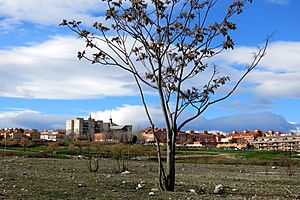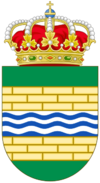Ciempozuelos facts for kids
Quick facts for kids
Ciempozuelos
|
|||
|---|---|---|---|
 |
|||
|
|||

Location of Ciempozuelos in Madrid
|
|||
| Country | Spain | ||
| Autonomous community | Community of Madrid | ||
| Area | |||
| • Total | 49.64 km2 (19.17 sq mi) | ||
| Elevation | 567 m (1,860 ft) | ||
| Population
(2018)
|
|||
| • Total | 24,087 | ||
| • Density | 485.23/km2 (1,256.75/sq mi) | ||
| Time zone | UTC+1 (CET) | ||
| • Summer (DST) | UTC+2 (CEST) | ||
| Website | www.ayto-ciempozuelos.org | ||
Ciempozuelos is a town in Spain. It is located in the Community of Madrid. The town covers an area of about 49.64 square kilometers. As of 2022, around 25,383 people live there.
Contents
Geography of Ciempozuelos
This town is located near the Jarama river. The Jarama river flows along the eastern edge of the town. This river is an important natural feature of the area.
History of Ciempozuelos
Early Settlements and Name Origin
In the Middle Ages, Ciempozuelos was a small village. It was part of the land of Segovia. People in the past got their water from underground caves. These caves were the main source of water for the town.
The name Ciempozuelos means "one hundred wells." This is because there was a channel that supplied a fountain in the town square. The water from the spring was not enough. So, the town built many wells to get more water.
It is believed that the first people to live here permanently were Romans. They might have called the area Ischadia. This name means "land of fig trees."
Prehistoric Discoveries
Between 1894 and 1895, important discoveries were made in Ciempozuelos. Scientists found ancient pottery from the Bell Beaker culture. This culture existed during the Copper Age and early Bronze Age. These findings tell us about very old human activity in the area.
The pottery was found during a quick digging project. It was done by the Royal Academy of History. The exact spot where they found these items is now unknown. It is thought that a road was built over the site. This road is now called M-404. The site was likely near the Cerro del Castillejo, close to the Ciempozuelos train station.
Growth and Development
In the Middle Ages, Ciempozuelos joined the council of Segovia. However, the number of people living there became very small. The area was successfully repopulated in 1457. A few years later, it became part of the county of Chinchón.
Modern Times and New Facilities
In the 19th century, a railway line was built. This line connected Madrid to Aranjuez. Ciempozuelos got its own railway station on this line. This made travel and trade much easier for the town.
In the second half of the 19th century, two special care centers were built. These centers were for people needing specific kinds of support. They were built by a group called the 'brotherhood' of San Juan de Dios and Father Benito Menni.
Notable people
- Ventura Rodríguez Tizón (1717–1785) was born in Ciempozuelos. He was a very famous Spanish architect and artist. He helped design parts of the Royal Palace of Aranjuez. He also designed the famous Cibeles fountain.
- Antonio de Oro Pulido (born 1904) was born in Ciempozuelos. He was a Spanish military officer and explorer. He also worked as a colonial administrator.
- Thess Mostoles (born 1995) was born in Ciempozuelos. She is a financial journalist who works in the UK. She has also worked with The New York Times. In 2022, she was chosen as one of the top 10 journalists under 30 in the world for broadcasting. This was by the AIPS organization.
- Francisco José Martín Gutiérrez, known as Paco Martín, (born 1967) is a former Spanish basketball player.
See also
 In Spanish: Ciempozuelos para niños
In Spanish: Ciempozuelos para niños




